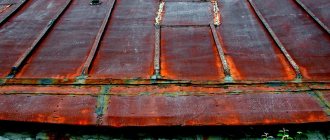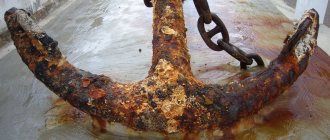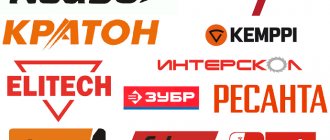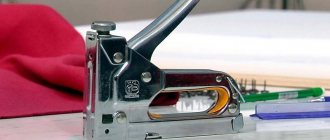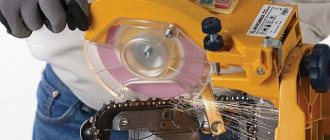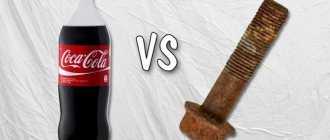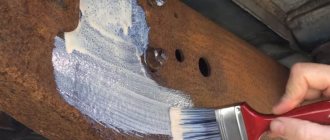11/15/2019 Author: VT-METALL
Issues discussed in the material:
- Why is it important to protect metal products from corrosion?
- What types of corrosion exist?
- What are the ways to protect metal products from corrosion?
Man has been using objects made of metals since ancient times. Until now, they remain an important component of our lives, and the most popular are products made of iron and its alloys. However, they all have one serious drawback, namely susceptibility to corrosion, that is, the ability to be destroyed during the oxidation process. Timely protection of metal products from corrosion makes it possible to increase their service life.
Passive and active methods of protection
All main methods of protecting pipelines from corrosion come down to performing a number of works. If we talk about passive methods, they are expressed as follows:
- a special installation method, when resistance to corrosion is thought out at the stage of pipeline installation. To do this, an air gap is left between the ground and the pipe, thanks to which neither groundwater, nor salts, nor alkalis will get inside the pipeline;
- applying special coatings to pipes that will protect the surface from soil influences;
- treatment with special chemicals, for example, phosphates, which form a protective film on the surface.
A protection scheme based on active methods involves the use of electric current and electrochemical ion exchange reactions:
- electrical drainage protection to combat stray currents;
- anodic protection, which slows down the process of metal destruction;
- cathodic protection, when direct current increases the resistance of metals.
Typical types of rust damage
The following types of destruction are distinguished:
- the surface is completely or partially covered with rust;
- small spots of rust are visible, which penetrate pointwise into the object;
- destruction in the form of a deep crack;
- destruction of one of the metals in the alloy occurs;
- deep penetration is observed over the entire surface;
- a combination of several techniques is possible.
According to the method of interaction of the metal with the external environment, chemical corrosion and electrochemical corrosion are distinguished. In the first case, rust is not associated with exposure to electric current, but in the second, the interaction of the metal surface with the electrolyte occurs.
Ways to combat corrosion
Metal corrosion is a destructive, lattice-destroying, redox chemical process. It is most often caused by the high chemical activity of the metals themselves - many remember from the school chemistry course the “line” of the activity of elements. It can be activated when unfavorable conditions are created, for example, high humidity and low temperatures, in an aggressive salt, acidic or alkaline environment.
Most often we have to deal with corrosion of ferrous metals, that is, various types of steel and cast iron, used literally everywhere, in all spheres of human activity. The process begins to reveal itself by the appearance of red stains or stains on the metal surface.
If corrosion is not dealt with, it can show its extremely destructive power - metal products quickly become unusable.
If no steps are taken, the outbreak begins to grow, capturing more and more areas. And sometimes this happens unnoticed. Thus, many areas of mechanisms, instruments, etc. - are simply hidden from view, and can only be seen when the unit or entire device is completely disassembled. And other pockets of corrosion may be hidden under a layer of paint for the time being, and only when the process has gone very far - first appear in the form of swellings, and then as rust breaks out.
Some owners try to deal with identified pockets of corrosion mechanically. That is, by grinding the damaged area with sandpaper or special discs, reaching the “healthy” metal.
However, such a technique, if it can be applied, should be done with extreme caution, and only as a preliminary step, before applying special compounds. Only mechanical cleaning is a very ineffective means
Spot corrosion showing through the paint layer
It is especially difficult to remove small pinpoint rust using this method, since during the cleaning process they become clogged with finely dispersed corrosive dust, and they become practically invisible. But the trouble is that they don’t go away, and will definitely show themselves in the future, even after coloring. Therefore, chemical treatment is more reliable.
In addition, if thin metal is affected by rust, then during cleaning, under the pressure of brushes or abrasive material, it can be damaged down to a through hole.
In this regard, it is recommended to use chemical compounds that clean the metal and prevent the occurrence of corrosion in the future. Moreover, with their help, you can even successfully deal with outbreaks in hard-to-reach areas, where you cannot reach the affected area by any other means without disassembling the mechanism.
Fire protection for your wooden house and bathhouse
Wooden houses, baths, saunas are places with high humidity and fire danger. Their surfaces require additional treatment with protective compounds: fire retardants, antiseptics and special varnishes/primers. Competent fire and bioprotection of a wooden house and bathhouse allows... Read more
Types of corrosion
Over the entire period of working with metal products, people have identified several types of metal corrosion:
- Soil corrosion is a type of corrosion that affects structures located in the ground. Due to the special composition of the soil and the presence of groundwater, chemical processes occur that cause rust.
- Atmospheric - an oxidation process that occurs during contact of air water vapor with a metal surface. The more harmful substances in the air, the faster corrosion will appear.
- Liquid - metal structures located in water are susceptible to this type of corrosion. If the liquid contains salt, the process of destruction of the material will proceed faster.
The choice of anti-corrosion composition depends on the environment in which the metal part will be used.
a brief description of
Safety glasses are an integral part of production processes, laboratory research, and are constantly used during construction work. They protect the face from splashes of hot metal, welding, droplets of aggressive liquid, infrared and ultraviolet radiation. In addition to glasses, there are also screens that look like a plate, rounded at the edges, with a head mount. There are a great variety of devices. They can have an elongated shape to protect the neck, and additionally be equipped with a plastic visor to hide the frontal part.
Impact-resistant materials are used in the manufacture of products: organic glass, polycarbonate and others. They are not afraid of chemical and mechanical damage, withstand significant temperature changes, providing one hundred percent visibility.
Some difficulties may arise when using personal protective equipment:
- field of view may be limited;
- Prolonged wear may cause discomfort;
- fogging of glass when working in hot shops.
In the production of face shields, modern high-tech equipment and high-quality and reliable materials are used that meet all safety requirements. A technology is used that makes it possible to use structures in any climate.
A distinctive feature of the product is its low weight to completely eliminate the load on the neck and head. The shield should not cause irritation or allergies during prolonged use. The best popular models have soft hypoallergenic pads for wearing comfort. Durable and high-quality fasteners do not put pressure on the head.
The screens are 100% transparent and completely eliminate optical distortion, which makes it possible to increase productivity, improve the quality of products, and avoid eye fatigue during long-term work. Some models provide the ability to wear additional protective equipment: respirators, headphones, and so on.
Types of corrosion
Scientists have been fighting corrosion for a long time and have identified several main types:
- Atmospheric. Oxidation occurs due to contact with air oxygen and water vapor contained in it. The presence of pollutants in the air in the form of chemically active substances accelerates rusting.
- Liquid. It takes place in an aquatic environment; salts contained in water, especially sea water, accelerate oxidation many times over.
- Soil. Products and structures located in the ground are susceptible to this type. The chemical composition of the soil, groundwater and leakage currents create a special environment for the development of chemical processes.
Based on the environment in which the product will be used, suitable methods of corrosion protection are selected.
Methods for increasing resistance
Corrosion resistance can be achieved by adding special elements (stainless steels). Such additives are nickel, manganese, chromium, copper, cobalt in a certain dosage.
The process of metal rusting can also be prevented by removing from its composition components that accelerate the destructive process (oxygen and sulfur from steel alloys, iron from aluminum and magnesium alloys).
Varieties and classification
Metal paints that are used to protect against the appearance and development of corrosion are divided into the following types:
For example, enamel primer for metal. Paints of this group are most effective for application to structures that are constantly in water or in the open air. The dye is a fast-drying substance. It dries completely within 2-3 hours after application to the surface to be treated.
Passivating
The purpose of such primer-paint is to slow down the development of corrosion. The advantages include high efficiency in slowing down oxidative processes. Due to this property of the paint, it is used in places of high humidity.
Converter
The composition includes phosphoric acid. After contact with corrosion, it forms a strong and stable iron phosphate. Thanks to this property, the paint not only protects the structure from rust, but also partially restores damaged areas.
Two-component phosphating agent
It consists of phosphoric acid and passivating additives, this makes it possible to use the product to protect galvanized structures from corrosion.
A quick-drying and economical primer-paint. Its anti-corrosion properties make it possible to paint products in conditions of high humidity. It contains dissolved tiny metal particles. After complete drying, it forms a durable and reliable metallized coating.
It has high anti-corrosion and adhesive properties. Thanks to the unique formula of the composition, when applied to an area affected by corrosion, it acts as a primer.
Thanks to them, the object not only becomes immune to corrosion, but also significantly improves the appearance of the metal structure.
Manufacturers produce anti-corrosion paints, which are divided into the following classifications:
Epoxy enamels
The synthetic resins from which the dye is made protect metal structures from exposure to high temperatures. The toxicity of the components included in the composition does not allow the frequent use of enamels in everyday life.
Oil paints
A dye based on natural drying oil. Painting structures located outdoors is not so effective. Oil paints cannot provide adequate protection against corrosion and subsequent destruction.
Alkyd paints
Substances intended for painting galvanized surfaces, resistant to high temperatures and flammable
When working with them, it is important to follow safety precautions and protect the dye from exposure to open flames.
Acrylic dyes
Despite their recent appearance on the market, they quickly gained popularity. Effectively and reliably protect metal structures from destruction. Used for both interior and finishing work.
Hammer paints.
The characteristics of this coloring substance make it possible to obtain a rough surface with a pronounced metallic sheen. Among the components in the composition are alkyds, epoxides, aluminum powder and acrid. The features of hammer paint include the ability to be used to protect non-ferrous metals. There is no need to use a primer when processing this material. The dye is applied in three layers: the first acts as a primer, the anti-corrosion coating is implemented in the second layer. The third one acts as enamel. Hammer paint cannot be used to treat metal products that will subsequently heat up above 150 °C during use.
Epoxy resin based paints and varnishes
Epoxy resins are used to make a huge number of materials for various applications. They are used in the radio electronics, electrical engineering, shipbuilding, aircraft and mechanical engineering industries, including as film-forming paints and varnishes, as components of impregnating and casting compounds, sealants, adhesives, etc. A wide selection of film formers allows you to create products with a wide variety of properties (for example, EP-741 varnish, HP-0064 putty). These compounds are used for anti-corrosion protection of products made of wood, concrete, plastics, metal structures and others. About 50% of the total world production of epoxy resins is used for these purposes. More details
Protective paints for metal
According to the operating temperature conditions, paints are divided into two large groups:
- conventional, used at temperatures up to 80 °C;
- heat resistant.
Based on the type of binder base, the paints are:
- alkyd;
- acrylic;
- epoxy.
Paint and varnish coatings for metal have the following advantages:
- high-quality surface protection against corrosion;
- ease of application;
- quick drying;
- many different colors;
- long service life.
Hammer enamels are very popular, not only protecting the metal, but also creating an aesthetic appearance. Silver paint is also common for metal processing. Aluminum powder is added to its composition. Metal protection occurs due to the formation of a thin film of aluminum oxide.
Silver paint
Two-component epoxy mixtures have exceptional coating strength and are used for components subject to high loads.
Which rust converter is best to buy?
As you can see, all rust converters for cars cope with the task assigned to them to one degree or another. Some turn the damaged area into soil, others form a protective film and prevent the lesion from growing. However, the most important condition for their effective action is strict adherence to the rules for applying the drug and preparing the surface to be treated as specified by the manufacturer.
Depending on the quality of the effect and the method of application of the product, the following conclusions can be drawn:
- Many car owners consider the American-made Hi Gear aerosol to be the most effective rust converter.
- Among the domestic products, the highest quality and most effective drug is the rust converter Tsinkar.
- If you have to treat a small surface against corrosion, you should opt for Fenom FN956.
- Liquid rust converter “Khimik” is suitable for those who need a large amount of product to treat a surface significantly damaged by corrosion.
- The ability to remove rust in hard-to-reach places is guaranteed by Astrochem aerosol.
- For those who value not only quality, but also a convenient method of application, without bubbles or drips, the Permatex gel rust converter is suitable.
This rating examined the 6 best rust converters for cars, and all of them protect the vehicle from corrosion quite well. But here is the main advice that experienced mechanics give: when fighting iron oxidation, you should not delay treating the damaged surface for too long; it is better to neutralize small lesions than to restore large areas.
Inhibitor compositions
Most often, compositions based on sodium nitrite are used, which are added to sodium silicates and phosphates, brines, sodium bichromates, sulfoxides, amines, tannin, etc.
Moreover, when using one or another inhibitor, it is important to take into account that the defense reaction involves its consumption, therefore it is periodically necessary to introduce new portions of the active element into the aggressive environment. For example, a typical composition of a corrosion inhibitor based on sodium nitrite is added in a volume of up to 0.05%
Also, the active groups of compounds behave differently in certain environments. So, if the task is oxidation, then hydroquinone is taken as a basis, and to delay rust processes in relation to steel alloys, the use of technetium is recommended. Specialized compounds include inhibitors for protection in environments with chlorine and hydrogen. In this case, nitrogen trichloride is used, but in minimal doses. As a rule, a thousandth of the total amount of reagents is enough to stop a negative interaction.
What is better to use for a wooden house: tow, moss or sealant?
What is better to use for a wooden house or bathhouse: tow, moss or sealant?
This question faces everyone who builds their own wooden house. It doesn’t matter what is used to create a log house - logs or beams, there will still be gaps between them. These are the ones you should get rid of first. For these purposes, in our country it has traditionally been customary to use natural materials moss and tow. But today a new product has appeared - sealant. It is also used for insulating seams between logs and for sealing chips and cracks on wooden surfaces. More details ↑ Up
The SpetsEmal company provides you with paint and varnish materials for various purposes: for railway transport, chemical resistant, electrical insulating, fire protection and others. Please note that we also supply fire retardant materials for wood, metal, concrete, textiles, plastic. An assortment of paints and varnishes on a different basis: KO, AK, AS, FL, HP, EP, VL, GF, HS guarantees the satisfaction of your needs! Special prices apply: putty ep-0010, enamel primer xc-0320, varnish BT-577, ograx, enamel os-12-03.
The best hammer paints for rust
Hammer paints form a specific rough coating, creating the effect of being hammered. At the same time, the enamel perfectly protects against moisture and temperature changes. After assessing the technical characteristics and feedback from specialists, 2 winners were selected that met the necessary requirements.
Hammerite
...I used enamel to paint a metal door to evaluate the strength of the hammer effect. Hammerite well masks unevenness that has arisen during the use of the canvas and creates a visually impressive coating... Expert opinion
Another best anti-rust paint to protect metal during both exterior and interior work. It adheres well to substrates with signs of rust due to its high adhesion rate. The enamel creates a smooth coating with excellent water-repellent properties even on a rusty, unprepared surface and completely hardens within 2 hours after application. The product has excellent heat resistance, maintaining its integrity even when heated (up to 80°C).
Hammerite is designed to protect ferrous metals exclusively. It contains corrosion-inhibiting components - alkyd varnish, sunlight-resistant pigments and functional additives. It is allowed to start painting when the air is heated to 5°C with a roller, brush or spray, which allows you to choose the most convenient tool in each specific case. After applying the base coat, wait at least 5 hours. The manufacturer offers 11 shades.
Advantages
- Resistance to aggressive factors;
- Ease of application to corrosion areas;
- Does not require preparatory work;
- Suitable for outdoor and indoor work;
- Lead free.
Flaws
- Not low cost;
- Hammerite solvent is required for dilution.
Zip Guard
This is a urethane rustproof paint designed for metal surfaces, but it is also suitable for concrete and wood. Enamel can be used directly in areas with signs of corrosion. In this case, it is not necessary to carry out any actions to clean the affected areas, except in cases where there is swelling of the old coating - they must be removed.
In the production of Zip Guard, the Ziprust technology is used, which allows you to apply a layer without the prior use of primers. Enamel can be used for interior and exterior work. It is a one-component composition and creates a corrosion-resistant coating due to the combination of the properties of the soil, anti-corrosion components and the finishing composition.
Advantages
- Protection of all types of surfaces, not just metal;
- There is no need for surface preparation;
- Suitability for external and internal work;
- Creation of a durable coating with anti-corrosion properties.
Flaws
- Glossy surfaces must be sanded before painting;
- It takes a long time to dry.
Use of inhibitors at home
For general users, the most affordable means of corrosion protection using inhibitors is to apply a primer compound to the target surface. This is a lightweight inhibitory coating, the effect of which is to prevent direct contact of water or an aggressive solution with the metal surface. Often paints and varnishes contain similar corrosion inhibitors. Substances used for such purposes are produced in factories. These include red lead for the same primer, solutions of zinc or iron orthophosphates, phosphate coatings, etc.
Reduction of environmental aggressiveness and electrochemical protection
By adding inhibitors to the external environment, the oxidation process can be stopped. They allow chemical reactions to slow down hundreds of times.
The electrochemical potential of steel changes under the influence of electric current. This process allows you to slow down or stop the rusting process.
Primers and phosphating against metal corrosion
The second type of corrosion protection is to apply a small amount of primer under a layer of varnish or paint. The elements that make up it must also have inhibitory properties. If this condition is met, water will pass through the primer layer, dissolving a certain amount of pigments, thereby becoming less aggressive. Red lead is recognized as one of the most effective elements for soils.
There are cases when, instead of a primer, the surface of metal products is phosphated. This process is carried out by applying to the required area solutions of manganese (II), iron (III), or zinc (II) orthophosphates, which also contain orthophosphate acid itself. It is worth noting that phosphating is carried out for 30-90 minutes at a temperature of 97-99 C.
To carry out phosphating of steel surfaces, there are a large number of special preparations that consist of iron and manganese phosphates. Many experts note. That the most effective such remedy is “mazhef” - a mixture of dihydrogen phosphates of manganese, iron and phosphoric acid.
If phosphating is carried out using this drug, the product must be placed in a special solution heated to 100C. Inside the mixture, harmful elements are removed from the surface of the metal with abundant release of hydrogen, resulting in a strong, dense and almost insoluble layer of iron and manganese of black-gray color. As soon as the layer thickness reaches a certain level, the dissolution of substances stops.
The phosphate film turns out to be effective in protecting the structure from atmospheric agents, but is not able to protect even from weak acid solutions. From all that has been said, we can conclude that the phosphate layer of protection can only serve as a foundation for the further application of decorative and protective coatings.
Why use body film?
Traveling along the highways is not complete without stones flying out from under the wheels of neighboring cars. And in the city it’s no better: you don’t know in advance where the body will “catch” a stone and get a scratch. On the paintwork, but the feeling is according to your heart.
In the parking lot, too, someone will catch your favorite swallow with their door. As a result, even a new car acquires “battle scars” after a year or two. Not pleasant.
Every driver has ever thought about applying vinyl, liquid rubber or the vaunted “ceramics” to the body. We once reviewed popular options for such “protective tuning” - here is a link to the article.
Actually, they expect simple, understandable measures from the film - decorate the car at an inexpensive price, save on polishing and painting elements. Plus some kind of protection, but it seems.
What to look for when choosing a rust converter?
To choose the best neutralizer, you should pay attention to several basic criteria:
- Subject of processing. If the product is intended to process metal for painting, it is best to purchase a simple converter. To prepare the structure for a new paint coating, a converter for the car body is suitable. If a more reliable treatment is needed, it is worth purchasing a neutralizer with a primer effect that covers the metal with a protective film - such a layer prevents corrosion and levels the base for further painting.
- Release form. The choice of a specific consistency of the product depends on the type of surface being treated - a wide horizontal area, vertical, hard-to-reach place or small metal parts. It depends on this which form of release will allow you to most comfortably treat a particular area, whether it will be a liquid, gel or spray.
- Rust thickness. The deeper the corrosion layer, the more difficult it is for the converter to cope with it. The ideal result is achieved when working with shallow layers of metal damage - 0.01 mm or less. A thicker layer of rust requires a longer surface treatment process.
All about modern decorative plasters
Modern decorative plasters are an excellent choice of paints and varnishes for renovation and construction of a house or apartment. Their use makes it possible to improve the appearance of structures, hide and eliminate visible defects, improve the indoor microclimate, and facilitate subsequent work. The main thing for today is to understand all the diversity presented in order to get the ideal final result. More details
Which rust converter is best to buy?
The modern market offers a huge range of corrosion removal products. However, which product is best will depend on the type of work to be done. If you want a super durable coat that will last for a long period of time, then we recommend Permatex, which also works like a primer.
If you are faced with the task of getting to deeply hidden pockets of corrosion, then pay attention to Autoprofi and Hi-Gear, which, thanks to convenient sprayers, will do all the necessary work. If you are looking for something cheap and time-tested, then Tsinkar is your choice
No matter which product you choose, never neglect protective equipment. The acidic composition of converters can adversely affect the eyes and respiratory tract.
Direct and indirect problems associated with metal corrosion
The main problem with corrosion is the gradual destruction of corroded parts of structures and products. At the same time, the degree of damage cannot always be assessed by appearance, and the loss of strength becomes unexpected and critical.
Intercrystalline corrosion, that is, passing along the boundaries of crystals, is especially strong. Externally, the process may be completely unnoticeable, while the level of strength loss reaches 50...60%.
Surface destruction has the least impact on the strength properties of products.
The photo shows part of the structures of the Shukhov Tower in Moscow. Surface rusting has significantly reduced structural strength, but has not led to the destruction of the structure (yet)
It is extremely difficult to estimate the level of losses from metal corrosion. The point is not even in direct losses from the destruction of corroded parts or structures, but in downtime of equipment and structures and disruptions in their performance as a whole, associated with the corrosion destruction of individual elements.
Waterproofing foundations and roofs
Proper waterproofing of the foundation and roof is extremely necessary as one of the stages of building a house or bathhouse. Already during the laying of the building, work should be carefully carried out on the foundation. Creating an insufficient or poor-quality water-repellent layer on it can subsequently lead to serious damage to the entire structure as a whole. More details

